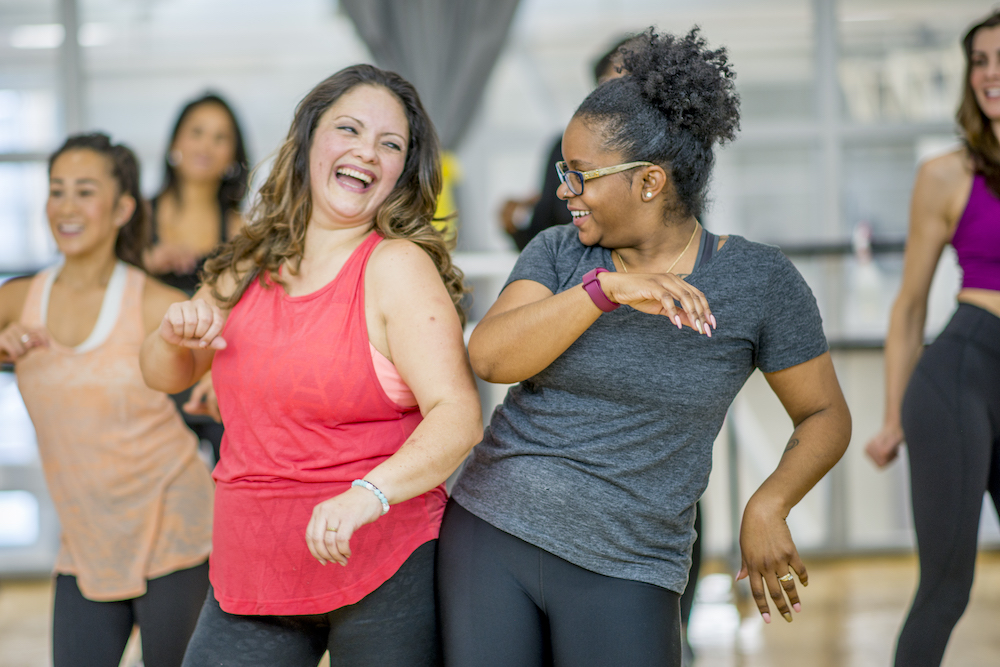Making lifestyle changes really worked for me when I started experiencing frustrating menopause symptoms. Using my personal training experience, I’ve shared tips on how to find the best exercise for you during menopause and how to create a menopause workout routine that sticks.
Find what you need quickly
- My menopause experience
- Does exercise really help menopause symptoms?
- What is the best exercise for menopause?
- How can you get motivated to exercise during menopause?
- Is it too late if you’ve never exercised before?
- What exercise should you start with?
- How to make time for exercise
- How do you step up your menopause exercise routine?
My menopause experience
My symptoms started around 48 but only started impacting the quality of my life when I reached 50.
They creep up on you slowly and unless you’ve chosen to do your research, they can be hard to recognize as hormonal. At first, I dismissed them:
- Joint pain? I’m getting older and do a lot of exercise
- Disturbed sleep? Stress about my teenagers, ageing dad and general life
- No libido? Same partner for 30 years, this was bound to happen
- Brain fog/memory loss? I’m expected to remember and organise everything for everyone, what do you expect?’
- Erratic mood swings. Now this is where I had to take stock
I could swing from happy, to tearful, to rage, all in the space of one game of cards with the kids! My poor husband didn’t know which version of me to expect when he walked into a room – and often he got all three. This wasn’t just a normal bad mood, it felt like someone had taken over my mind and was controlling my emotions.
But I was lucky. By then I’d decided to leave a 25-year HR career and retrain as a personal trainer. As part of that journey, I did a huge amount of research into menopause and learned that these changes are all part of being perimenopausal. Plus, there was a lot I could do to help myself.
I learned how to adapt my nutrition, stress management, exercise, and sleep to help my symptoms. After a lot of research, I started taking HT, for its short and long-term benefits. After four months of this approach, I happily started to recognize myself again.
Read more about the risk and benefits of HT.
But it’s a work in progress. The brain fog and memory loss still aren’t resolved. Yes, that’s me walking 20 minutes to the bike repair shop and only then realizing I’d left the bike at home! Plus, my swimming teacher thinks I’m the world’s most absent-minded person after I forgot my swimming gear for the third week in a row! Ever dried yourself with a paper towel?
Does exercise really help menopause symptoms?
Studies have shown exercise can help reduce vasomotor symptoms, such as hot flashes, and night sweats, as well as brain fog, and migraines. But more crucially, there is extensive evidence that exercise improves mental health, which can especially help during menopause. That’s one of the reasons that it’s worth exploring the link between exercise and menopause, especially if you’re dealing with lots of ups and downs.
If you feel strong emotionally, you’ll feel more able to deal with whatever comes your way – and with hormones being the fluctuating little devils they can be, this could vary from day to day!
Energy and disturbed sleep are typical in menopause and while it sounds counterintuitive, many studies have proven that exercise helps boost energy levels which promotes better sleep. Good levels of sleep and exercise lead to better nutritional choices and there’s a positive impact on reaching a healthier weight too.
It’s important to understand that this change is driven by your body, not by you. Before menopause, your progesterone levels help by buffering against stress-induced cortisol spikes. The body’s ability to do that reduces as the levels of progesterone lower during perimenopause, and so you become less able to deal with stress. This higher cortisol level can cause many typical perimenopause symptoms including disturbed sleep, weight gain, feeling down, food cravings, and low libido.
Exercise doesn’t have to mean long gym sessions or crazy cardio workouts.”
How to get started
If you’re not yet exercising, just start walking. Simply getting your body moving and doing something positive for yourself helps your mood and makes you feel more in control. And that helps you cope with feeling anxious, depressed, and stressed.
What is the best exercise for menopause?
Your muscle mass naturally declines from your thirties onwards and accelerates once you hit perimenopause as your estrogen levels drop. This can affect your power, balance, strength, and aerobic capacity.
Declining estrogen, the key hormone protecting and maintaining your bone health, means osteoporosis is a real threat as your bone breaks down faster than it repairs.
The good news is that it’s not too late to do something about it. For optimum health, your menopause exercise routine should include:
1) Cardio. For heart health, plus great for endorphins!
2) Resistance training. Improves bone density, reduces the risk of bone fractures, and creates leaner muscle mass.
3) Yoga/Pilates. For flexibility, agility, posture, and stress management.
What cardio is best for menopause?
Firstly, choose something you enjoy and are going to continue doing. Consistency and building a routine are really important when it comes to exercise.
Secondly, think about your goal. If it is weight management, you may need to make some changes to your current exercise routine. HIIT workouts may now be causing far too much stress on the body, which can increase visceral fat storage. As an alternative, you may want to consider swapping your HIIT to running, cycling, spinning, swimming, or hiking.
Try different approaches to find out what works for you. You are unique and everyone responds in different ways to the changes during menopause – so your menopause exercise routine will be as unique as you are.
Resistance training
Also called strength training, resistance training refers to using weights, bands, or body weight to create resistance for the bones and muscles in the body to move against. Put simply, the more work you give your bones and muscles to do, the stronger they’ll become. They respond to the exercise by renewing themselves.
How often do you need to do exercise?
Ideally, try to fit 20-30 mins sessions in two to three times a week. If you can only manage smaller chunks of time, try and do them daily.
Session length will depend on you. Some will be OK starting with 30 minutes while others will find that overwhelming and intimidating. Don’t set yourself unrealistic expectations.
Find the routine that works for you and stick with it.”
How can you get motivated to exercise during menopause?
I have a client who finds it easier to squeeze exercise ‘chunks’ into her day than a full workout. She can be found doing 25 sit-ups whilst sorting the laundry or 10 push-ups every time she makes a pot of coffee!
I share short six to 12-minute workouts on my Instagram page. Peri- and postmenopausal women send me DMs saying ‘Six minutes? Even I can try that!’ and then message the next day ‘I DID IT! Twice through!’ Or someone will message me to say they started my three-minute daily abs challenge and are rightly proud of choosing something over nothing.
Top Tips
It’s the starting that’s the hard part. My advice to create lasting habit change:
- Start small
- Set yourself up to succeed
- Then take small incremental steps from there
Is it too late if you’ve never exercised before?
It’s not too late if you’ve never exercised or it’s been years since you last did – menopause can be a great time to start! Aside from the great physical benefits, the huge impact on your mental well-being could get you hooked.
What exercise should you start with?
I’d recommend walking as a great exercise for menopause. Get a step tracker (an app or a smartwatch) and see what your average daily step count is across seven days. If it’s 5,000 average steps daily – aim for 5,500 for the coming week. Try for 6,000 for the week after and aim to build up to between 8,000 and 10,000 steps.
From strength training to yoga, there’s something for all abilities and you can do it from the comfort of your own home.
How to make time for exercise
- Try making a work call on a walk instead of at your desk
- Make your regular family catch-up phone call a walk too
- If you’re ready to start resistance training, try a wall sit whilst you brush your teeth (squat with your back against the wall for balance). Or do some bodyweight squats. That’s four minutes a day which is 28 minutes a week – without even making time for a workout!
- Every time you put something in the microwave do 15 ab crunches
- Waiting for the toast to pop up? Do 10 static lunges!
- Long ad break on TV? Do 10 push-ups against the sofa or some tricep dips
Across the week, this all adds up and you WILL start to feel stronger – which in turn will motivate you to make time for more exercise.
How do you step up your menopause exercise routine?
If you’re already exercising but feel ready to do more, reach out to a professional for some advice. You could also follow some great accounts for inspiration or ask your Stella coach.
Maybe it’s time to join a class, get some heavier weights, ask for a new gym program, or add in something new – hula hooping anyone? Sometimes we get into an old routine that no longer serves us.
Right, what’s stopping you?
Read more about menopause on our blog or in our symptoms library.





